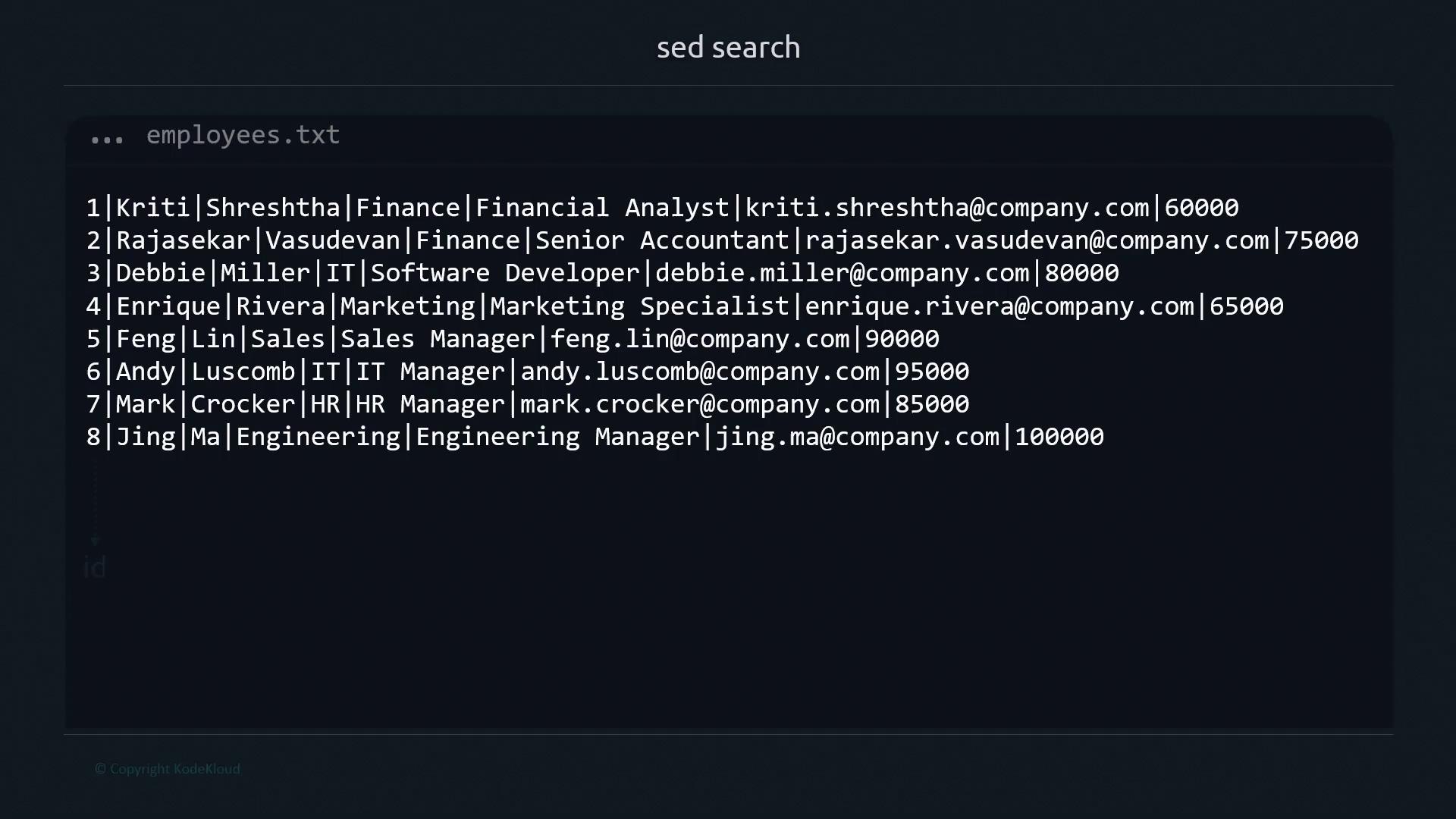Advanced Bash Scripting
sed
Find
Enhance your text-processing workflow by using sed to search, print, or delete specific patterns directly within files. While similar to grep, sed lets you combine pattern matching with editing commands in one step.
To follow along, we’ll use an employees.txt file with records formatted as ID|First|Last|Department|Role|Email|Salary.

1. Basic Search Syntax
sed requires both a pattern and an action. The minimal form is:
sed '/pattern/' file
Without an explicit action, sed may default to printing every line or throw an error:
$ sed '/Manager/' employees.txt
# (No command given; behavior depends on your sed version)
To print only matching lines, use -n (quiet mode) with the p command:
sed -n '/Manager/p' employees.txt
-n: suppress automatic printing/Manager/: search for “Manager”p: print matching lines
$ sed -n '/Manager/p' employees.txt
5|Feng|Lin|Sales|Sales Manager|[email protected]|90000
6|Andy|Luscomb|IT|IT Manager|[email protected]|95000
7|Mark|Crocker|HR|HR Manager|[email protected]|85000
8|Jing|Ma|Engineering|Engineering Manager|[email protected]|100000
Note
By default, sed performs case-sensitive matches. Searching for manager (lowercase) yields no results:
$ sed -n '/manager/p' employees.txt
# No match
2. Searching Substrings
Match partial strings by specifying only a fragment:
$ sed -n '/Ma/p' employees.txt
4|Enrique|Rivera|Marketing|Marketing Specialist|[email protected]|65000
5|Feng|Lin|Sales|Sales Manager|[email protected]|90000
6|Andy|Luscomb|IT|IT Manager|[email protected]|95000
7|Mark|Crocker|HR|HR Manager|[email protected]|85000
8|Jing|Ma|Engineering|Engineering Manager|[email protected]|100000
This matches “Marketing”, “Manager”, “Mark”, and the last name “Ma”.
3. Exact Word Matches with Word Boundaries
Use \< and \> to match whole words only:
sed -n '/\<Ma\>/p' employees.txt
$ sed -n '/\<Ma\>/p' employees.txt
8|Jing|Ma|Engineering|Engineering Manager|[email protected]|100000
Command breakdown:
sed: invoke stream editor-n: suppress default output/\<Ma\>/: match exact word “Ma”p: print matching line
4. Combining Multiple Search Patterns
Chain multiple scripts with -e to search for more than one pattern:
sed -n \
-e '/\<Manager\>/p' \
-e '/\<IT\>/p' \
employees.txt
$ sed -n -e '/\<Manager\>/p' -e '/\<IT\>/p' employees.txt
3|Debbie|Miller|IT|Software Developer|[email protected]|80000
5|Feng|Lin|Sales|Sales Manager|[email protected]|90000
6|Andy|Luscomb|IT|IT Manager|[email protected]|95000
7|Mark|Crocker|HR|HR Manager|[email protected]|85000
8|Jing|Ma|Engineering|Engineering Manager|[email protected]|100000
Lines matching either pattern appear once per script.
5. Deleting Matches
Swap p for d to remove matching lines:
Remove Enrique’s record:
sed -e '/\<Enrique\>/d' employees.txt
Delete all lines containing “Ma” as a whole word:
$ sed -e '/\<Ma\>/d' employees.txt
1|Kriti|Shreshtha|Finance|Financial Analyst|[email protected]|60000
2|Rajasekar|Vasudevan|Finance|Senior Accountant|[email protected]|75000
3|Debbie|Miller|IT|Software Developer|[email protected]|80000
4|Enrique|Rivera|Marketing|Marketing Specialist|[email protected]|65000
5|Feng|Lin|Sales|Sales Manager|[email protected]|90000
6|Andy|Luscomb|IT|IT Manager|[email protected]|95000
7|Mark|Crocker|HR|HR Manager|[email protected]|85000
6. Editing Files In-Place with -i
Apply deletions or substitutions directly using -i:
$ sed -i \
-e '/\<Manager\>/d' \
-e '/\<IT\>/d' \
employees.txt
$ cat employees.txt
1|Kriti|Shreshtha|Finance|Financial Analyst|[email protected]|60000
2|Rajasekar|Vasudevan|Finance|Senior Accountant|[email protected]|75000
4|Enrique|Rivera|Marketing|Marketing Specialist|[email protected]|65000
Warning
Using -i overwrites your source file. Always keep backups or use version control.
7. Quick Reference: sed Flags
| Option | Description | Example |
|---|---|---|
| -n | Suppress automatic printing | sed -n '/pattern/p' file |
| -i | Edit files in-place | sed -i 's/foo/bar/' file |
| -e | Add multiple scripts | sed -e '/A/p' -e '/B/p' file |

Links and References
Watch Video
Watch video content